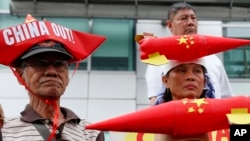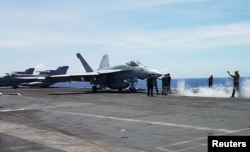Chinese missile deployment in the South China Sea is meant as a challenge to the United States and its allies, scholars believe.
Anti-ship cruise missiles and surface-to-air missiles that China reportedly installed on islets in the sea off its south coast would discourage passage of naval vessels from the United States or its allies such as Australia and Japan, analysts say. Vietnam, which claims parts of the sea occupied by China, has officially protested to Beijing.
China deployed the missiles in the sea’s Spratly Islands for military exercises in early April, according to a recent report by CNBC quoting “sources with direct knowledge of U.S. intelligence reports.”
China claims about 90 percent of the sea and opposes the passage of American naval ships, which Washington describes as freedom of navigation, or FONOP, exercises. The U.S. government calls the South China Sea, also claimed by five other Asian governments, an international waterway.
Australia and Japan support the U.S. cause, and they have become more outspoken in the past half-year. Japan sent a helicopter carrier to the sea for drills in mid-2017. Last month Australian naval vessels ran into Chinese ships in the same sea.
“I think (the missiles are) relevant to other countries as well, to Australia, to Japan, because their freedom of navigation will be put into danger when China can install so many high-tech missiles in the South China Sea,” said Trung Nguyen, international relations dean at Ho Chi Minh University of Social Sciences and Humanities.
Missile sightings
China built missile shelters on the islands in early 2017, but the April deployment “was the first confirmed placement of such platforms on the islands,” the U.S. think tank Center for Strategic and International Studies’ Asian Maritime Transparency Initiative says on its website.
Military units might have moved the missiles into those shelters after the exercises, the initiative’s director Gregory Poling said.
China has other military installations in the uninhabited Spratly archipelago. The initiative says China operates radar facilities on three islets: Fiery Cross, Mischief and Subi reefs. Military aircraft have landed at all three, it adds.
Deterring the United States
Analysts expect that China will avoid firing missiles to cause actual damage. But it might use them to deter U.S. freedom of navigation movements, scholars say.
The U.S. government will “think three times” about its movement now, said Alexander Huang, a strategic studies professor at Tamkang University in Taiwan.
“It’s posturing rather than actually shooting, so they send a political as well as military signal to the Seventh Fleet and to Washington, D.C., and even to the people on Capitol Hill that the South China Sea has at least two dominant powers and China is one of them,” Huang said. The Seventh Fleet is a U.S. naval fleet based in Japan.
China might fire off a missile “symbolically” if U.S. naval ships pass through the sea again, said Alan Chong, associate professor at the S. Rajaratnam School of International Studies in Singapore. Its actions may bear Japan in mind, too, he said.
“There could be a minor clash, meaning an American frigate symbolically stages one of those FONOPs and then (Chinese President) Xi Jinping under pressure, he symbolically says, ‘All right, I want to defend the nation,’ and he might fire something off at the Americans,” Chong said.
China might use the missiles to “block” another country’s passage, Nguyen said.
The U.S. government has carried out six freedom of navigation operations since President Donald Trump took office in 2017.
Rigorous monitoring
Brunei, Malaysia, Taiwan, the Philippines and Vietnam claim all or parts of the South China Sea. Their claims overlap those of China. Most are looking in the sea for fisheries as well as oil and natural gas.
Vietnam protested to China on May 8 and demanded that it remove any missiles. The Philippines is studying whether to make its own protest.
The missiles pose a “long-term danger to Vietnam’s interests in the South China Sea,” Nguyen said, especially to Vietnamese airfields nearby.
But the neighboring countries will probably make few changes in view of any missiles, said Jonathan Spangler, director of the South China Sea Think Tank in Taipei. He sees no threat to marine shipping and notes that China regularly passes coast guard ships throughout the sea.
The missiles would mark a “slow progression” in a militarization aimed at stopping any invasion of Chinese-held islets, he said.









